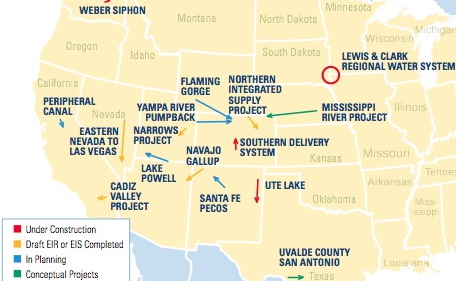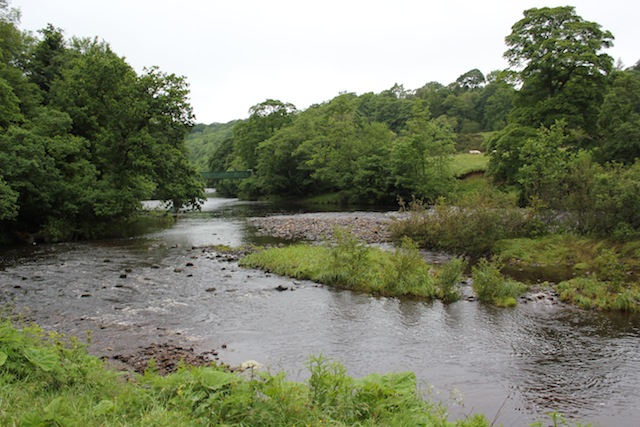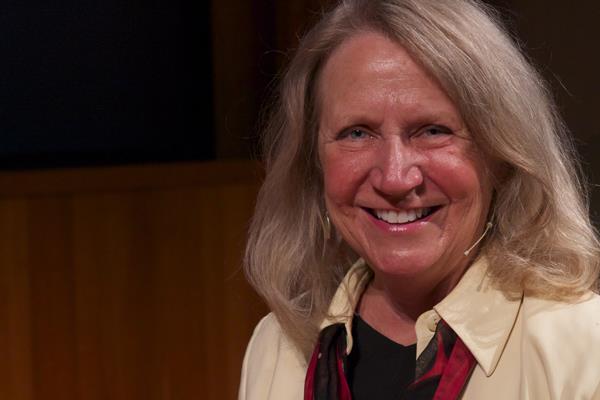I vote for him
Posted on | July 3, 2012 | 1 Comment

 Unfortunately, Jay Famiglietti isn’t running for office, unfortunate because the University of California scientist has character to match his smarts. The Irvine-based hydrologist is shouting from roof tops about how disastrous a course we are taking by, say, investing more in the space program, energy and mineral studies and weather prediction than understanding Earth’s fresh water supply. He’s not saying spend less on those other things, but more on understanding fresh water so that we can plan for the future with some semblance of understanding of how much water will be available, where, how and when. Some may remember the Famiglietti “We’re screwed” quote from “Last Call at the Oasis,” spiritedly reprised recently by a fellow hydrologist at WaterWired. Others may recall the 2011 Famiglietti-led study that found we had already over drafted the groundwater of California’s Central Valley by enough water to fill Lake Mead, America’s largest reservoir. Now, in a new post for National Geographic, Famiglietti lays out what we don’t know about the dynamics and quantity of our fresh water supply (most everything, says the expert), why we need to get up to speed fast (the old water and life thing), and how this must shoot straight to the top of public policy. If you drink water, or eat food, or require shade etc, you want to read the National Geographic post and then write someone who is running for office or, preferably, in it, and hold their feet to the fire. Unless you or your children plan to live on some as yet discovered planet, no plan, not for health care, not economic recovery, not for national security, means a thing if the country destroys its watersheds.
Unfortunately, Jay Famiglietti isn’t running for office, unfortunate because the University of California scientist has character to match his smarts. The Irvine-based hydrologist is shouting from roof tops about how disastrous a course we are taking by, say, investing more in the space program, energy and mineral studies and weather prediction than understanding Earth’s fresh water supply. He’s not saying spend less on those other things, but more on understanding fresh water so that we can plan for the future with some semblance of understanding of how much water will be available, where, how and when. Some may remember the Famiglietti “We’re screwed” quote from “Last Call at the Oasis,” spiritedly reprised recently by a fellow hydrologist at WaterWired. Others may recall the 2011 Famiglietti-led study that found we had already over drafted the groundwater of California’s Central Valley by enough water to fill Lake Mead, America’s largest reservoir. Now, in a new post for National Geographic, Famiglietti lays out what we don’t know about the dynamics and quantity of our fresh water supply (most everything, says the expert), why we need to get up to speed fast (the old water and life thing), and how this must shoot straight to the top of public policy. If you drink water, or eat food, or require shade etc, you want to read the National Geographic post and then write someone who is running for office or, preferably, in it, and hold their feet to the fire. Unless you or your children plan to live on some as yet discovered planet, no plan, not for health care, not economic recovery, not for national security, means a thing if the country destroys its watersheds.
Photos: Top: Jay Famiglietti. Source: University of California, Irvine. Below, USGS hydrologist Joseph Poland posing by a telephone pole in the Central Valley near Mendota, California. Click here for the USGS fact sheet on subsidence for more on Poland and the impact of groundwater mining.
High good, low bad: Mead in June 2012
Posted on | July 1, 2012 | No Comments

“Pipe Dreams: Water Supply Pipeline Projects in the West” by Barry Nelson of the Natural Resources Defense Council and Denise Fort of the University of New Mexico Law School looks at the demand posed by projects in watersheds already stressed by runaway development. Click on the graphic to be taken to the June 2012 report.
Lake Mead, the Colorado River storage reservoir serving California, the Southwest and Mexico, lost nearly four feet in June, 2012, a month in which a research team from the Natural Resources Defense Council and University of New Mexico published a report that finds five new projects aiming big straws at the river.
“Pipe Dreams” estimates the draw of the new projects at more than 690,000 acre feet per year, a drain that would come on top of what the Bureau of Reclamation already describes as structurally embedded “over-allocation” of the Colorado River. Allowing for northern states and river tribes to realize their full allocations, and after factoring in climate change, the bureau estimates that the Colorado could be facing a 3.5m acre feet per year deficit by mid-century. To put that in perspective, that is roughly one-fifth of its traditionally estimated 17m acre feet annual flow, a seasonal yield that is expected to diminish as long-term estimates are revised and the region warms with climate change. The Colorado River supplies roughly one-third of Southern California’s residential water, along with all of the irrigation for Imperial Valley’s farming operations. Click here to keep reading
Tags: "Pipe Dreams" > chance of rain > Colorado River > Lake Mead > Natural Resource Defense Council
Impressions from England
Posted on | June 29, 2012 | 2 Comments
It was dumb luck that a series of storms had rivers running high during a recent trip to northeastern England. According to family who live in Teesdale, in a village roughly 50 miles south of Newcastle, only months ago, during what notionally should have been a wetter period, flows of the Tees and Balder had been scant. It was a dry January when Northumbrian Water coughed up a drought plan. But precipitation did finally happen. Bang on summer solstice, these rivers crashed and roared like a freeway. As rain and safety releases from local reservoirs swelled their banks, the water ran brown as newly brewed coffee, frothing with swept-up soil. Stubborn foam settling in eddies made me wonder if sewers hadn’t been overwhelmed? It was a series of days so wet that across Pennines, the northerly rib of moors dividing eastern and western England, western counties were on flood alert and said to be getting a month’s rain in a day. The east was notionally drier, except Cotherstone, where I was, and where neighbors of my family kept apologizing for the weather until the sagest of my cousins waved them off, laughing, “She loves it! She’s from LA!” Click here to keep reading
Should “green streets” be streets?
Posted on | June 18, 2012 | 3 Comments
The $270 million question soon to be put to homeowners by the Los Angeles County Department of Public Works is: Will we pay an annual tax of $54 per parcel toward a basin-wide effort to clean at least some of the pollutants swept up in water as it flows from paved surfaces into the storm drain system, rivers and Pacific? This much is clear: We should. This much isn’t: Will we? And, even if we do, will it work before fines over Clean Water Act violations start kicking in and law suits begin?
$270 million a year sounds like a lot until you divide it between 88 cities, a spangling of watershed NGOs and the county Flood Control District. Even if divided proportionately to size of city, the sum starts sounding woefully inadequate considering that alone one storm water park opened in February that was wrought from an old bus yard in South LA cost $24m, or that only one of the most celebrated of LA’s tiny string of “green streets” cost a million bucks. Who knew that opening up concrete curbs to allow rain and dry season sprinkler run-off to meander through bio-filtration swales came with such price tags?
While it’s clear that we must act, it’s also clear that there is no one solution. There are so many pollutants, from plastic bags to pesticides, that we have to meet the challenge with a world of incentives. Now is the time to speak up. For Los Angeles County to seriously invest in clean water, it needs its residents drunk on the possibilities. We have to understand why it will be not just a new tax, but also a door opening to a beautiful and wondrous new era for Los Angeles. Next to an affair to remember with Vigo Mortensen, it should be a dream to dream, night after night, year after year, decade after decade.
Here’s mine. Why not make Clean Water Act compliance part of an overall, systemic park program on par with the Olmsted-Bartholomew plan? When it comes to green streets, let’s ask first if they should be streets at all? Great swathes of the buildings covering our watershed date from a time when stables and garages were accessed by alleys. The alleys have become dilapidated and such a drag on cities that they are subject to all manner of schemes. The going drive is to retire them. But why not keep the alleys and ditch lousy streets? Why not close off streets for parks, rehabilitate alleys for cars and use valley-size retired avenues to take urgently needed cool, green park space to the most depressed, hard-baked, alley-rich sectors of LA? An emerging network of greenways could lead strategically to revitalized creeks and rivers recharged by systematically filtered flows from surrounding communities. The more our parks led to natural waterways, the more we would come to make the connections between our lawn run-off and a storm drain and a creek and a river and the mighty Pacific. Most importantly given the enormity of the challenge, the easier it would be for LA County to get us to open our check books year after year for clean water, be it with parcel taxes or other levies. With every park, bonds would strengthen between neighbors and neighborhoods. Dream this kind of road-for-parks scenario long enough and the potential benefits are so numerous that the capacity for groundwater recharge and filtration of water destined for rivers seem almost like a perk rather than the point.
Tags: chance of rain > Clean Water Act > Clean Water Clean Beaches Measure > Emily Green
ALOUD: Moore / Childs / Deverell
Posted on | June 12, 2012 | No Comments
The Los Angeles Public Library is offering a free podcast of last week’s “Aloud” lecture “Reflections on Moving Water” with philosopher Kathleen Dean Moore, essayist Craig Childs and historian William Deverell.
A snippet, from Moore: “In my mind it’s water that helps us understand that this blue green world is all one deeply interconnected, deeply interdependent, beautiful and mysterious whole thing. And that the flourishing of all the parts depends on the flourishing of the whole. It’s water that teaches us we that are all part of this homeland. And who are we in this beautiful world? We are sloshy things, right? We are sacks of sea water. We are water that has developed the ability to walk uphill. We are water that has developed the ability to celebrate its own beauty in poetry, praise and song. It wasn’t so long ago that our ancestors spoke to storms with magical words and prayed to water and cursed it and danced for it. And we are water that has developed the ability to imagine. We have developed the ability to imagine things that have absolutely no relationship to the real world. And we have developed the ability to live in that imagined world, so that we can believe, we can imagine that we are exceptions to all the rules, even the rules of cause and effect. That we are above this world, apart from it, better than it, in control of it. We can imagine that we can squander water without squandering our futures.” To listen, click here.
« go back — keep looking »





